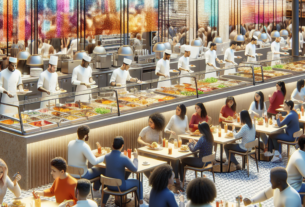The State of the Global Grocery Retail Industry in 2025
The grocery retail industry is constantly evolving, with new technologies being implemented to improve efficiency and customer experience. In 2025, grocery brands are increasingly using technology to reduce checkout times and streamline the shopping process for consumers. This report will delve into the current trends, challenges, and opportunities in the global grocery retail industry, with a focus on how technology is being leveraged to enhance the checkout experience.
Current Trends in the Global Grocery Retail Industry
In 2025, the global grocery retail industry is experiencing a shift towards digitalization and automation. Many grocery brands are investing in technology to improve the shopping experience for customers and increase operational efficiency. Some of the key trends in the industry include:
1. Contactless Payments: With the rise of digital wallets and mobile payment apps, grocery brands are increasingly offering contactless payment options to customers. This allows for a faster and more convenient checkout experience, as customers can simply tap their smartphones or cards to pay.
2. Self-Checkout Kiosks: Self-checkout kiosks are becoming more prevalent in grocery stores, allowing customers to scan and pay for their items without the assistance of a cashier. This reduces wait times at the checkout counter and provides customers with a more seamless shopping experience.
3. Mobile Apps: Many grocery brands are developing mobile apps that allow customers to create shopping lists, find product information, and even check out without having to wait in line. These apps also offer personalized discounts and promotions, making the shopping experience more convenient and engaging.
4. RFID Technology: Radio-frequency identification (RFID) technology is being used by some grocery brands to track inventory and improve supply chain management. RFID tags on products enable real-time tracking of items, reducing out-of-stock situations and ensuring that shelves are always well-stocked.
Challenges in Implementing Technology in the Grocery Retail Industry
While technology offers numerous benefits to grocery brands, there are also challenges associated with implementing new systems and processes. Some of the key challenges include:
1. Cost: Implementing new technology can be costly for grocery brands, especially for small and medium-sized businesses. It requires significant investment in hardware, software, and training, which may not always yield immediate returns.
2. Integration: Integrating new technology with existing systems can be complex and time-consuming. Grocery brands need to ensure that their new systems are compatible with their current infrastructure and processes to avoid disruptions in operations.
3. Security: With the increase in digital transactions and data collection, grocery brands need to prioritize cybersecurity to protect customer information and prevent data breaches. This requires robust security measures and ongoing monitoring to identify and mitigate potential threats.
4. Customer Adoption: While many customers appreciate the convenience of technology in the shopping process, some may be resistant to change or unfamiliar with new systems. Grocery brands need to educate and incentivize customers to use new technology to ensure widespread adoption.
Opportunities for Grocery Brands to Reduce Checkout Times
Despite the challenges, there are significant opportunities for grocery brands to leverage technology to reduce checkout times and enhance the overall shopping experience. Some of the key opportunities include:
1. Automated Checkout: Implementing automated checkout systems, such as self-checkout kiosks and cashierless stores, can significantly reduce wait times for customers. These systems use AI and computer vision to scan items and process payments quickly and accurately.
2. Mobile Payment Integration: Integrating mobile payment options, such as Apple Pay and Google Pay, into existing checkout systems can streamline the payment process and reduce friction for customers. This allows for faster transactions and a more seamless shopping experience.
3. In-Store Navigation: Grocery brands can use technology to help customers navigate the store more efficiently and find products quickly. Interactive maps and location-based services can guide customers to items on their shopping list and reduce the time spent searching for products.
4. Personalized Discounts: By leveraging data analytics and AI, grocery brands can offer personalized discounts and promotions to customers based on their purchase history and preferences. This not only incentivizes repeat purchases but also speeds up the checkout process by reducing the time spent searching for deals.
Case Study: Amazon Go
One notable example of a grocery brand using technology to reduce checkout times is Amazon Go. Amazon Go is a chain of cashierless convenience stores that rely on computer vision, sensor fusion, and deep learning algorithms to enable customers to grab items off the shelves and walk out without having to wait in line.
The Amazon Go stores use a combination of cameras and sensors to track customers and their purchases as they move through the store. Customers simply scan their Amazon Go app upon entering, pick up the items they want, and then leave the store. The app automatically charges their account for the items they take, eliminating the need for a traditional checkout process.
Amazon Go has been highly successful in reducing checkout times and providing customers with a seamless shopping experience. The technology used in Amazon Go stores has paved the way for other grocery brands to explore cashierless solutions and automate the checkout process.
Future Outlook for Grocery Brands Using Technology
Looking ahead, the future of the grocery retail industry is likely to be increasingly digital and automated. Grocery brands will continue to invest in technology to reduce checkout times, improve customer satisfaction, and drive operational efficiency. Some key trends to watch for in the coming years include:
1. AI-Powered Shopping Assistants: AI-powered shopping assistants will become more prevalent, helping customers find products, make purchase decisions, and navigate the store more efficiently. These assistants can offer personalized recommendations and streamline the shopping process for customers.
2. Augmented Reality: Augmented reality technology will be used to enhance the in-store shopping experience, allowing customers to visualize products in their homes before making a purchase. This technology can help reduce the time spent comparing products and increase customer engagement.
3. Voice Commerce: Voice-activated shopping through smart speakers and virtual assistants will become more common, allowing customers to add items to their cart and place orders with simple voice commands. This technology will simplify the checkout process and provide a hands-free shopping experience.
4. Sustainability Initiatives: Grocery brands will increasingly focus on sustainability and eco-friendly practices, using technology to track and reduce waste, optimize energy consumption, and promote ethical sourcing. These initiatives will not only benefit the environment but also appeal to environmentally conscious customers.
In conclusion, the global grocery retail industry is undergoing a digital transformation, with technology playing a key role in reducing checkout times and enhancing the overall shopping experience. By investing in innovative solutions such as automated checkout systems, mobile payment integration, and personalized discounts, grocery brands can stay ahead of the curve and meet the evolving needs of customers in 2025 and beyond.


